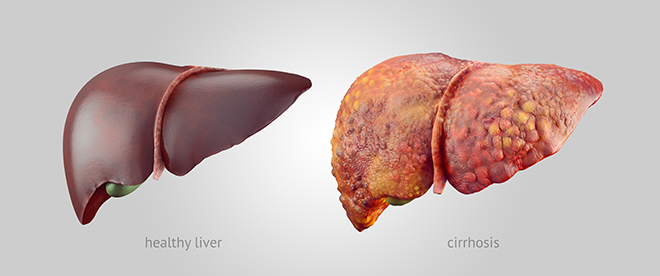Definition & Facts for Cirrhosis
In this section:
- What is cirrhosis?
- How common is cirrhosis?
- Who is more likely to develop cirrhosis?
- What are the complications of cirrhosis?
What is cirrhosis?
Cirrhosis is a condition in which the liver is scarred and permanently damaged. Scar tissue replaces healthy liver tissue and prevents the liver from working normally. Scar tissue also partly blocks the flow of blood through the liver. As cirrhosis gets worse, the liver begins to fail.
Many people are not aware they have cirrhosis, because they may not have any signs or symptoms until their liver is badly damaged.
 A healthy liver (left) and a liver with cirrhosis (right).
A healthy liver (left) and a liver with cirrhosis (right).How common is cirrhosis?
Researchers estimate that about 1 in 400 adults in the United States have cirrhosis.1 Researchers believe the actual numbers may be higher than that because many people with cirrhosis are not diagnosed. Many people with early stages of cirrhosis may not be diagnosed if they have few symptoms or do not feel ill.
Who is more likely to develop cirrhosis?
People are more likely to develop cirrhosis if they have health conditions that can cause cirrhosis. Cirrhosis is also more common in people who
- have a history of heavy alcohol use
- have overweight or obesity
- have type 2 diabetes
- are men
- are age 40 or older2
What are the complications of cirrhosis?
As the liver fails, complications may develop. In some people, complications may be the first sign they have cirrhosis.
Portal hypertension
Portal hypertension is a serious problem caused by cirrhosis and can lead to some of the most common complications of cirrhosis. Portal hypertension occurs when scar tissue in the liver slows the normal flow of blood, which causes high blood pressure in the portal vein. The portal vein is the large blood vessel that carries blood from the stomach, intestines, spleen, gallbladder, and pancreas to the liver.
When portal hypertension reaches a certain level, it can cause complications, such as
- buildup of fluid in the abdomen or belly, called ascites. Ascites can lead to a serious infection—called peritonitis —in the space that surrounds the liver and intestines.
- swelling in the legs, ankles, or feet, called edema.
- enlarged veins—called varices—in the esophagus, stomach, or intestines. These varices can lead to internal bleeding if the veins burst.
- confusion or difficulty thinking caused by a buildup of toxins in the brain, called hepatic encephalopathy.
Infections
Cirrhosis increases your chance of getting bacterial infections, such as urinary tract infections and pneumonia.
Liver cancer
Cirrhosis increases the chance of getting liver cancer.3 Most people who develop liver cancer already have cirrhosis.
Liver failure
Cirrhosis may eventually lead to liver failure, also called end-stage liver disease. With liver failure, the liver is badly damaged and stops working. People with liver failure may require a liver transplant.
Other complications
Other complications of cirrhosis may include
- bone diseases, such as osteoporosis
- gallstones
- problems with the bile ducts—the tubes that carry bile out of the liver
- malabsorption and malnutrition
- bruising and bleeding easily
- falls
- sensitivity to medicines
- insulin resistance and type 2 diabetes
References
This content is provided as a service of the National Institute of Diabetes and Digestive and Kidney Diseases
(NIDDK), part of the National Institutes of Health. NIDDK translates and disseminates research findings to increase knowledge and understanding about health and disease among patients, health professionals, and the public. Content produced by NIDDK is carefully reviewed by NIDDK scientists and other experts.

